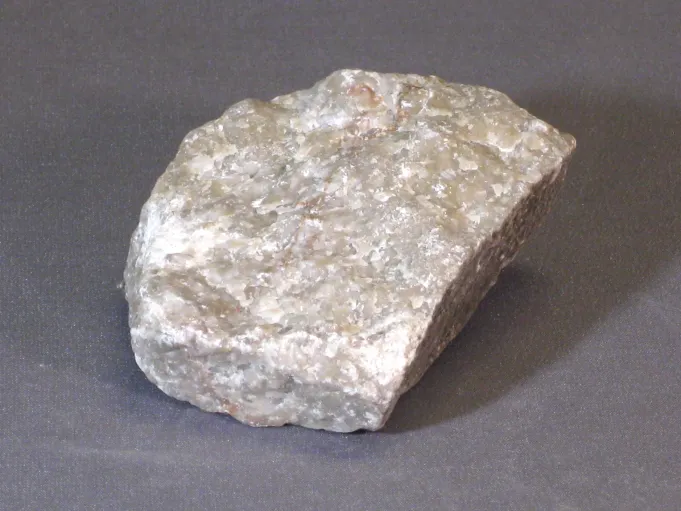
Appearance
Depending on the impurities it contains, limestone can have a variety of colors, from white and gray to yellow, brown, and even black. Its textures range from coarsely crystalline to finely grain.
Geographical Distribution
In the shallow waters of the ocean between 30 degrees north latitude and 30 degrees south latitude, the majority of them can be found. In the Caribbean Sea, Indian Ocean, Persian Gulf, Gulf of Mexico, surrounding islands in the Pacific Ocean, and inside the Indonesian archipelago, limestone is developing.
History
Throughout history, limestone has been used extensively in construction and architecture. Limestone was used in the construction of numerous well-known structures and sites, including as the Parthenon in Athens and the Great Pyramids of Giza.
Metaphysical Properties
An assisting stone, limestone may improve healing qualities, promote purification, serve as a reminder of our innocence, center ourselves, and inspire optimistic thinking.

Chemical Composition
The main ingredient in limestone is calcium carbonate (CaCO3), which is found in the mineral calcite. Other minerals including dolomite (CaMg(CO3)2), clay minerals, and other impurities could also be present. The geological conditions in which limestone evolved determine its purity.
Types
Classification based on composition:
Calcitic Limestone:
Calcite, or calcium carbonate, makes up the majority of this kind of limestone. It is among the most common varieties of limestone.
Dolomitic Limestone:
In addition to calcite, dolomitic limestone also contains a considerable proportion of calcium magnesium carbonate (Ca Mg (CO3)2). Its unique qualities are due to the presence of magnesium. This kind is utilized in agriculture because of its well-known capacity to balance soil acidity.
Magnesian Limestone:
Magnesium carbonate (MgCO3) is present in large concentrations in Magnesian limestone. It is employed in numerous industrial processes as well as the manufacturing of magnesium metal.
Marine Limestone:
Coral and other marine animal remains combine to make this kind of limestone. It is frequently utilized in the construction of monuments and buildings and is frequently rich in fossils.
Chalk:
The small remnants of sea plankton make up the majority of the finely grained, soft, porous limestone known as chalk. It is utilized as a building material, for writing and sketching, and is often white or light gray in color.
Oolitic Limestone:
Small, round, or egg-shaped structures known as ooids make up oolitic limestone. It is frequently utilized in architectural applications and has a fairly permeable quality.
Travertine:
A type of limestone called travertine is left behind by mineral springs, particularly hot springs. It is known for being used in sculptures and building facades, and it frequently has a banded or layered appearance.
Classifying according to texture:
Crystalline Limestone:
Large calcite crystals are frequently seen in crystalline limestone, which has a well-developed crystalline structure. It has decorative uses and has the potential to be visually arresting.
Clayey Limestone:
This particular type of limestone has a texture with fine grains because it contains a lot of clay. In addition to various industrial uses, it goes into the production of cement.
Coquina:
Coquina is a kind of limestone composed of bits of coral and shell that have been weakly bonded. It is employed in some landscaping and building applications and is rather soft.
Sandy Limestone:
Large amounts of sand-sized particles are present in sandy limestone. It is occasionally employed as a building material.
Fossiliferous Limestone:
This kind is rich in fossils and is classified more as a textural feature based on the presence of fossils that have been preserved.
Uses
- Construction: A common building material for a variety of construction projects is limestone. It is utilized in the construction of walls, monuments, bridges, and structures. Because of its durability and aesthetic appeal, limestone is used.
- Cement Production: An essential component in the creation of cement is limestone. Cement is made from it by grinding it into a fine powder and combining it with clay and other ingredients. Cement is used extensively in the building industry.
- Agriculture: Limestone is used to raise the pH of the soil and increase its quality. Aglime, another name for agricultural limestone, is added to soils to lower acidity and give crops vital nutrients.
- Crushed Stone: After being crushed into smaller pieces, limestone is used to build driveways, sidewalks and roads. In addition, crushed limestone is utilized as a foundation material for building projects and in landscaping.
- Industry: Numerous industrial operations make use of limestone. In the process of producing metals like steel and iron, it is used to eliminate impurities. Additionally, it is used in the manufacturing of plastics, paper, and glass.
- Water Treatment: In the water treatment industry, limestone is used to remove contaminants and modify the pH of water. It is a substance that is frequently used to neutralize acidic water.
- Art and Sculpture: Because of its relative softness, limestone is a perfect material for architectural decoration, sculpture, and carvings. Limestone was used to create many historical sculptures and building features.
- Fossil Collection and Research: Because limestone is rich in fossils, paleontologists and collectors who research prehistoric marine life can benefit much from it.
- Karst Landscapes and Caves: Karst terrain, sinkholes, and cave development are all dependent on limestone. There is scientific and recreational value to these natural features.
Table





